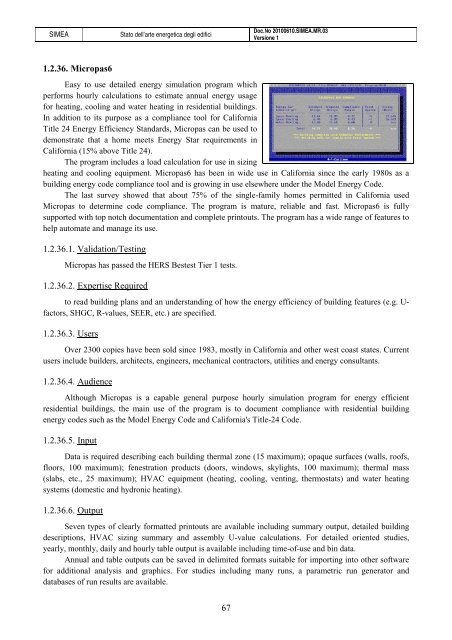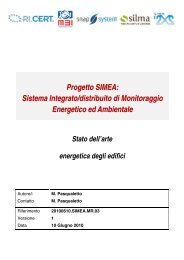Progetto SIMEA - Automatica - Università degli Studi di Padova
Progetto SIMEA - Automatica - Università degli Studi di Padova
Progetto SIMEA - Automatica - Università degli Studi di Padova
You also want an ePaper? Increase the reach of your titles
YUMPU automatically turns print PDFs into web optimized ePapers that Google loves.
<strong>SIMEA</strong> Stato dell’arte energetica <strong>degli</strong> e<strong>di</strong>fici<br />
1.2.36. Micropas6<br />
67<br />
Doc.No 20100610.<strong>SIMEA</strong>.MR.03<br />
Versione 1<br />
Easy to use detailed energy simulation program which<br />
performs hourly calculations to estimate annual energy usage<br />
for heating, cooling and water heating in residential buil<strong>di</strong>ngs.<br />
In ad<strong>di</strong>tion to its purpose as a compliance tool for California<br />
Title 24 Energy Efficiency Standards, Micropas can be used to<br />
demonstrate that a home meets Energy Star requirements in<br />
California (15% above Title 24).<br />
The program includes a load calculation for use in sizing<br />
heating and cooling equipment. Micropas6 has been in wide use in California since the early 1980s as a<br />
buil<strong>di</strong>ng energy code compliance tool and is growing in use elsewhere under the Model Energy Code.<br />
The last survey showed that about 75% of the single-family homes permitted in California used<br />
Micropas to determine code compliance. The program is mature, reliable and fast. Micropas6 is fully<br />
supported with top notch documentation and complete printouts. The program has a wide range of features to<br />
help automate and manage its use.<br />
1.2.36.1. Validation/Testing<br />
Micropas has passed the HERS Bestest Tier 1 tests.<br />
1.2.36.2. Expertise Required<br />
to read buil<strong>di</strong>ng plans and an understan<strong>di</strong>ng of how the energy efficiency of buil<strong>di</strong>ng features (e.g. Ufactors,<br />
SHGC, R-values, SEER, etc.) are specified.<br />
1.2.36.3. Users<br />
Over 2300 copies have been sold since 1983, mostly in California and other west coast states. Current<br />
users include builders, architects, engineers, mechanical contractors, utilities and energy consultants.<br />
1.2.36.4. Au<strong>di</strong>ence<br />
Although Micropas is a capable general purpose hourly simulation program for energy efficient<br />
residential buil<strong>di</strong>ngs, the main use of the program is to document compliance with residential buil<strong>di</strong>ng<br />
energy codes such as the Model Energy Code and California's Title-24 Code.<br />
1.2.36.5. Input<br />
Data is required describing each buil<strong>di</strong>ng thermal zone (15 maximum); opaque surfaces (walls, roofs,<br />
floors, 100 maximum); fenestration products (doors, windows, skylights, 100 maximum); thermal mass<br />
(slabs, etc., 25 maximum); HVAC equipment (heating, cooling, venting, thermostats) and water heating<br />
systems (domestic and hydronic heating).<br />
1.2.36.6. Output<br />
Seven types of clearly formatted printouts are available inclu<strong>di</strong>ng summary output, detailed buil<strong>di</strong>ng<br />
descriptions, HVAC sizing summary and assembly U-value calculations. For detailed oriented stu<strong>di</strong>es,<br />
yearly, monthly, daily and hourly table output is available inclu<strong>di</strong>ng time-of-use and bin data.<br />
Annual and table outputs can be saved in delimited formats suitable for importing into other software<br />
for ad<strong>di</strong>tional analysis and graphics. For stu<strong>di</strong>es inclu<strong>di</strong>ng many runs, a parametric run generator and<br />
databases of run results are available.
















